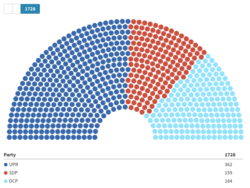1728 Florian Federal elections
All 705 seats to the House of Representatives 353 seats needed for a majority | |||||||||||||||||||||||||
|---|---|---|---|---|---|---|---|---|---|---|---|---|---|---|---|---|---|---|---|---|---|---|---|---|---|
| Turnout | 68.1% | ||||||||||||||||||||||||
|
| |||||||||||||||||||||||||
 | |||||||||||||||||||||||||
| |||||||||||||||||||||||||
The 1728 Florian Federal elections was the first federal election post Floxit. It determined the composition of the House of Representatives until the next presidential election expected to be held in 1740 AN.
Background
Enacted as the first law passed by President Hutchinson after the nation’s withdrawal from the Raspur Pact, All Members of the Florian Congress were put up for re-election. The election was promised if Floria was to leave the pact and that came to fruition.
The election promised to be the most significant federal election since constitutional reforms as a third party, the right-wing populist Democratic Conservative Party gained major support during the Raspur Pact referendum and their bid to topple the traditional Blue vs Red political scene. This was the first election where more than two parties were capable of winning a federal election.
Mostly against the backdrop of leaving the Raspur Pact Floria had somewhat unresolved issues regarding the economy, the future of the Confederate Armed Forces after Project 1727, opposition towards the Senate and tensions in Mesoun between Florian Loyalists and rebels.


